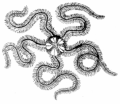Imagine you are walking in a wood, far from any man-made structure. Among the large variety and complexity of shapes around you, you will see some repeated forms. Regularities and symmetries start to appear. Even with the continuous change of nature, some things seem to be preserved, some directions of growth, or designs, seem to be favoured.
 From any wood you can see the sun as round as the full moon, rain falling in approximately spherical drops, or snow falling in hexagonal crystals.
From any wood you can see the sun as round as the full moon, rain falling in approximately spherical drops, or snow falling in hexagonal crystals.
The tree-trunks and mushrooms have rotational symmetry about a central axis. Flowers often have rotational symmetry of pentagonal, square or hexagonal type... Many insects, mammals and leaves have bilateral symmetry. Millepedes, blades of grass, or the leaves of ferns display the beginnings of translational symmetry..
These symmetries are hardly ever perfect: the leaves of a four-leaved clover are not exactly equal, so its symmetry is not as precise as that of a square. However, we will not be too bothered about this and say coolly that a star fish has pentagonal symmetry even if one of its five arms is folded or broken.
 Having awakened our curiosity, we can make some hypotheses about how and why nature is organised in symmetric shapes, hypotheses linked to criteria such as functionality, replacement, locomotion, or economy.
Having awakened our curiosity, we can make some hypotheses about how and why nature is organised in symmetric shapes, hypotheses linked to criteria such as functionality, replacement, locomotion, or economy.
A system evolves interacting with its environment and, if the external conditions that impose on it a particular effect have some symmetry, then the result may display, completely or partially, the symmetry of the cause that produced it. The Earth is not perfectly spherical because its rotation causes it to bulge out around the equator and so become flattened at the poles. However, the rotational symmetry about its axis and reflection symmetry with respect to the equator is preserved.
 Crystals are a notable example of regularity in the inorganic world. The crystals of salt, iron oxide and pyrite are respectively of cubic, octahedral, and dodecahedral shape. It is likely that the pyrite crystal suggested the dodecahedral shape to the ancient Greeks, who found it in Sicily, where it is abundant.
Crystals are a notable example of regularity in the inorganic world. The crystals of salt, iron oxide and pyrite are respectively of cubic, octahedral, and dodecahedral shape. It is likely that the pyrite crystal suggested the dodecahedral shape to the ancient Greeks, who found it in Sicily, where it is abundant.
Symmetrical structures can have advantages for living organisms. They are stable, compact, homogeneous, and interchangeable. As in a production line in a factory, they reproduce themselves more easily and quickly. A spherical body disperses less heat because a smaller surface area is needed to separate it from outside.
 As living organisms evolved, they lost the high degree of symmetry that is characteristic of lower orders. Many unicellular organisms, like the simplest ones suspended in water, are as symmetrical as possible, that is they have a spherical shape.
As living organisms evolved, they lost the high degree of symmetry that is characteristic of lower orders. Many unicellular organisms, like the simplest ones suspended in water, are as symmetrical as possible, that is they have a spherical shape.
More complex sea organisms, creatures like starfish or jellyfish, or plants that are fixed to the ground where they grow, are conditioned by the direction of gravity: their upper and lower parts are different, but they still have rotational symmetry about a (vertical) axis.

In higher organisms that move by themselves, like fish or mammals or birds, we can also distinguish the front (where the eyes are) from the back. But these creatures often preserve bilateral symmetry. This is favoured by linear motion and acts against helical motion (like a screw).
Even the human body has substantially bilateral symmetry. The embryo initially develops a repetitive translational structure. Such symmetry is then lost when the organs such as the heart or liver, of which we have only one copy, develop and position themselves off the central axis, or when the intestine, as it needs to lengthen, folds itself up.
Some crustaceans break their bilateral symmetry by developing one claw more than the other. If the largest claw is lost, a new one is generated in its place, while the other grows and becomes the largest one. The two possible shapes are reflections of each other.
 Translational symmetry is a property that applies only to unbounded figures. But a structure that grows in only one direction by repeatedly adding the same unit, like an ear of wheat, or an earthworm, is potentially symmetric with respect to translation: as time passes, new segments equal to the previous ones grow.
Translational symmetry is a property that applies only to unbounded figures. But a structure that grows in only one direction by repeatedly adding the same unit, like an ear of wheat, or an earthworm, is potentially symmetric with respect to translation: as time passes, new segments equal to the previous ones grow.
The need to fill all available space with the same unit gives rise to numerous symmetrical situations, for example the hexagonal structure of honeycomb, the tetrahedral symmetry of a foam of soap bubbles, the pigment of the retina in our eyes, or the polyhedral shape of some vegetable cells like those in the heart of a tree trunk or in the structure of some diatoms.